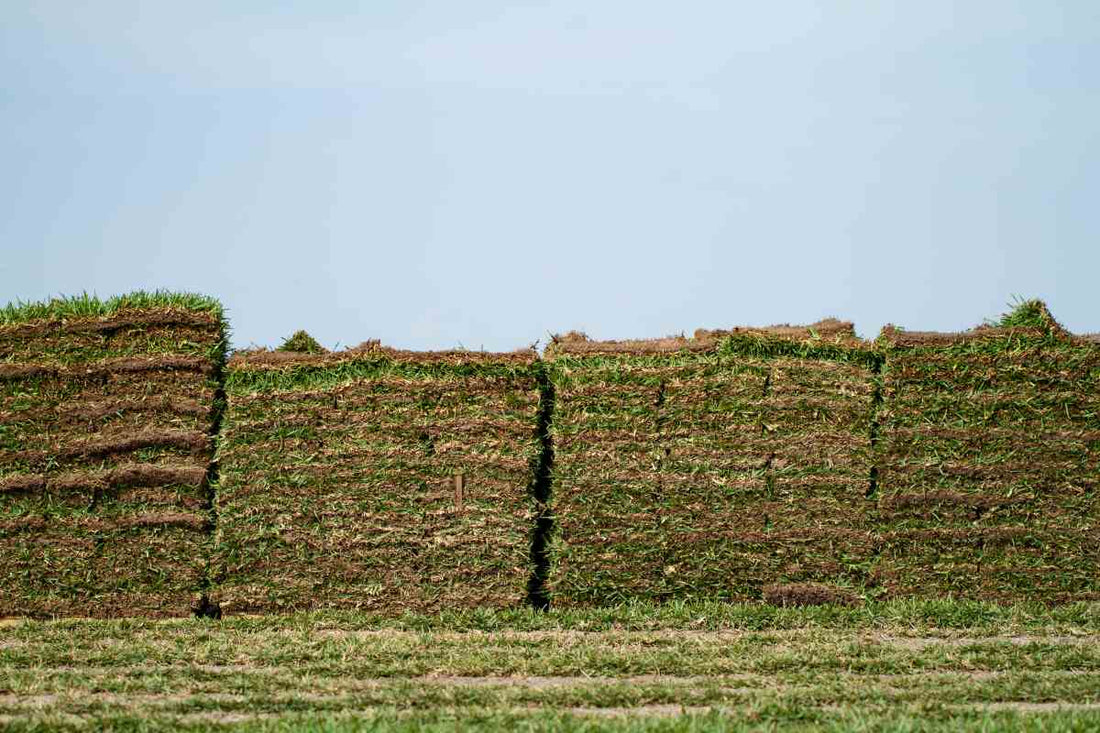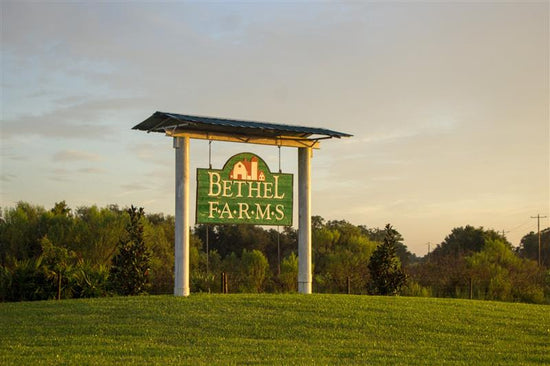
The Grass is Greener with Sod: What Makes Sod Eco-Friendly
Jamie TedderA well-maintained lawn does more than add curb appeal—it is essential to environmental sustainability. As concerns about climate change, water conservation, and soil health continue to grow, homeowners and landscapers are looking for solutions that balance beauty with ecological responsibility. While traditional landscaping methods are generally associated with high water usage and chemical inputs, sod offers a greener alternative by naturally preventing erosion, filtering rainwater, and even improving air quality. Its durability also helps create a resilient landscape that requires fewer treatments, contributing to a healthier, low-maintenance outdoor space.
But what makes sod truly eco-friendly? This article delves into the environmental benefits of sod, comparing it to other options like grass seed and artificial turf. It also explores how Bethel Farms is advancing sustainable sod farming through innovative water conservation techniques and responsible cultivation practices.
Understanding Eco-Friendly Landscaping
Sustainable landscaping prioritizes resource conservation, biodiversity, and reduced environmental impact. While traditional lawn care often relies on excessive water use, chemical fertilizers, and high-maintenance practices, eco-friendly alternatives promote healthier, more resilient landscapes.
One significant advancement in sustainable landscaping is sod itself, with improved varieties like BIMINI® Bermuda becoming increasingly available for professional and residential applications. These advanced sod types are engineered to be more drought-tolerant, resilient to heat stress, and resistant to wear and tear— addressing today’s pressing environmental challenges. With these innovations, sod continues to be a practical and eco-friendly solution, providing instant coverage while reducing long-term resource demands.

The Environmental Benefits of Sod
Sod plays a crucial role in sustainable landscaping by:
-
Preventing soil erosion.
-
Improving air quality through carbon sequestration.
-
Filtering water to reduce pollution.
-
Cooling the environment, mitigating the urban heat island effect.
By choosing the right sod and adopting responsible lawn care practices, you can enjoy a beautiful yard while minimizing environmental impact.
Soil Stabilization and Erosion Control
One of the most significant environmental benefits of sod is its ability to stabilize soil and prevent erosion. Unlike grass seed, which takes weeks to germinate and establish, sod provides immediate ground cover. This is particularly valuable in areas prone to heavy rainfall, construction sites, and sloped landscapes.
Sod significantly reduces soil erosion compared to bare soil or newly seeded areas. Its dense coverage acts as a protective barrier against soil erosion, shielding the ground from the impact of heavy rain and strong winds. As it establishes and anchors its roots into the soil, it helps prevent particles from being washed away by water or carried off by the wind—an essential function for maintaining soil stability, particularly in erosion-prone areas.
Carbon Sequestration and Air Quality Improvement
Sod acts as a natural carbon sink, absorbing carbon dioxide from the atmosphere and converting it into organic matter.
Research estimates that lawns in the US alone can sequester between 12.5 million and 95 million tons of CO₂ annually—equivalent to the emissions of 2.4 million to 18 million passenger vehicles per year. This makes sod important in reducing atmospheric carbon levels while simultaneously improving air quality.
Water Filtration and Pollution Reduction
Sod acts as a natural filter, reducing runoff and improving groundwater recharge. When rainwater flows through sod, its root system traps pollutants such as nitrogen, phosphorus, and heavy metals before they reach waterways. This reduces contamination in lakes, rivers, and groundwater supplies, making sod important in stormwater management.
By comparison, hard surfaces like concrete and artificial turf do not absorb water effectively, leading to increased runoff and potential flooding.
Cooling Effect and Heat Reduction
Sod significantly reduces heat in urban areas by absorbing sunlight and cooling the surrounding environment. Studies show that grass-covered surfaces can lower maximum surface temperatures by up to 75 degrees F compared to asphalt, helping to combat the urban heat island effect and create a more comfortable outdoor environment.
Unlike artificial turf, which retains heat and can reach temperatures exceeding 150°F in direct sunlight, sod maintains a comfortable temperature. This makes it a preferable choice for residential lawns, parks, and commercial landscapes where cooling effects and comfort are essential.

Sod vs. Grass Seed: Which is More Sustainable?
For homeowners looking for a low-maintenance yet high-appeal lawn, sod is often the better choice. While grass seed requires extensive watering, weeding, and months of growth before achieving full coverage, sod provides an instant, uniform lawn with minimal upkeep.
Water Usage
Establishing sod requires initial watering, but it ultimately consumes less water long-term than seeded lawns. Because sod has a fully developed root system upon installation, it retains moisture more efficiently and requires fewer irrigation cycles than newly seeded areas.
Time and Resource Efficiency
Sod provides instant green coverage, saving you from the long waiting period associated with grass seed. Seeded lawns are also more vulnerable to erosion and soil disturbance, whereas sod immediately protects the ground from runoff and environmental stress.
Long-Term Sustainability
A significant drawback of seeded lawns is their susceptibility to weed invasion. By the time the grass is dense enough to occupy the entire space, dandelions and other weeds may have already taken root, requiring more herbicide use. Sod-grown grass, on the other hand, is typically denser and more resistant to weeds, reducing the need for chemical treatments.
Innovations in Sustainable Sod Farming at Bethel Farms
Beyond the inherent eco-friendly benefits of sod, innovative farming practices further improve its sustainability. At Bethel Farms, we use advanced technology to conserve resources and minimize environmental impact.
Precision Irrigation with Telemetry Technology
Bethel Farms uses a telemetry system that monitors the specific needs of each field in real-time. This data-driven approach ensures that water, nutrients, and other resources are applied precisely where and when needed, reducing waste and maximizing efficiency.
Underground Water Tile Irrigation
Unlike traditional open irrigation systems that lose up to 40% of water through evaporation and runoff, Bethel Farms employs an underground tile irrigation system. This system delivers water directly to the roots, ensuring efficient water use while promoting healthier sod growth.
Reservoir System for Water Conservation
We have also implemented a reservoir system that serves a dual purpose:
-
Boosting water supply for irrigation, reducing dependence on municipal water sources.
-
Acting as a flood control measure, mitigating the risk of excess water runoff.
By leveraging these sustainable innovations, Bethel Farms sets an industry standard for eco-friendly sod farming.

Addressing Common Misconceptions About Sod
Is Sod More Water-Intensive Than Seed?
While sod requires frequent watering during the first 10–14 days for proper establishment, it gradually tapers to a regular watering schedule. Once established, its dense root system and greater drought resistance allow it to consume less water in the long term—still less than what a seeded lawn requires to reach full coverage.
Is Artificial Turf a More Eco-Friendly Option?
Artificial turf is sometimes marketed as a sustainable alternative to real grass because it requires no watering or mowing. However, artificial turf presents significant environmental drawbacks, including:
-
High heat retention, making it uncomfortable in hot climates.
-
Microplastic pollution, as synthetic fibers break down over time.
-
Lack of biodegradability, leading to landfill waste once the turf is replaced.
By contrast, natural sod provides environmental benefits such as carbon sequestration, soil health improvement, and cooling effects—making it the more sustainable choice in the long run.
Final Thoughts
Sod is more than simply an instant landscaping solution—it is an eco-friendly investment that improves soil health, conserves water, reduces heat, and improves air quality. Compared to grass seed and artificial turf, sod offers superior sustainability, efficiency, and environmental impact reduction.
Bethel Farms takes this commitment further by integrating cutting-edge technology to minimize resource use and maximize sustainability. From precision irrigation to underground water conservation systems, our long-term goal is to set a new standard for eco-friendly sod farming.
For homeowners, landscapers, and developers looking to make a greener choice, sod is the way forward—offering a healthier, more sustainable landscape for generations to come. Check out the Bethel Farms website today to explore our selection of premium sod grass for sale.

